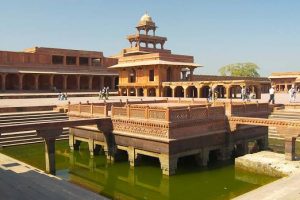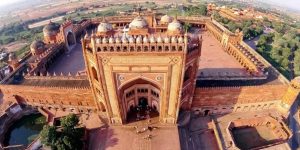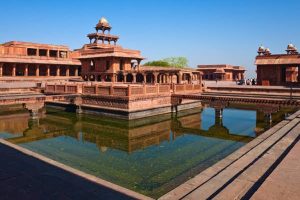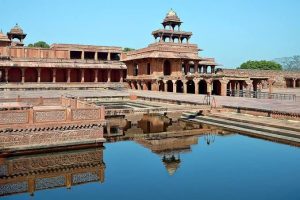Digital News Guru Education Desk:
Fatehpur Sikri Fort: A Testament to Mughal Grandeur
Nestled on a rocky ridge in Uttar Pradesh, the Fatehpur Sikri Fort is a UNESCO World Heritage Site that epitomizes the architectural brilliance and cultural synthesis of the Mughal era. Built during the reign of Emperor Akbar in the late 16th century, this historic fort stands as a timeless reminder of India’s rich history. Its fascinating blend of Persian, Indian, and Islamic architectural elements and its unique narrative make it one of the most significant landmarks in Indian history.
Historical Context
Fatehpur Sikri, meaning “The City of Victory,” was conceived as a grand capital by Akbar the Great, who reigned from 1556 to 1605. Akbar, known for his administrative acumen and inclusive policies, decided to construct this fortified city to commemorate his military victory over Gujarat. Additionally, the site held spiritual significance for the emperor. According to historical accounts, the Sufi saint Sheikh Salim Chishti, who resided there, foretold the birth of Akbar’s heir, Jahangir. This prophecy deeply influenced Akbar, leading him to establish Fatehpur Sikri as his capital in 1571.

Despite its grandeur, Fatehpur Sikri’s reign as a capital was short-lived. Due to water scarcity and logistical challenges, Akbar abandoned the city in 1585, relocating to Agra. However, the architectural marvels of the fort have endured, offering insights into the artistic and cultural zenith of the Mughal empire.
Architectural Splendor
The Fatehpur Sikri Fort is renowned for its harmonious fusion of diverse architectural styles. Built predominantly using red sandstone, the fort complex is a testament to Akbar’s vision of cultural amalgamation. The layout of the city reflects a meticulous blend of practicality, aesthetics, and spirituality.
Key Structures within the Fort
- Buland Darwaza
The Buland Darwaza (Gate of Magnificence) is one of the most iconic structures of Fatehpur Sikri. Standing 54 meters tall, this grand gateway was constructed to celebrate Akbar’s victory over Gujarat. Adorned with intricate inscriptions and carvings, the Buland Darwaza serves as a stunning example of Mughal ingenuity. - Jama Masjid
This sprawling mosque within the fort is one of the largest in India. Its massive courtyard, intricately designed prayer hall, and Persian-inspired motifs highlight the Mughal emphasis on grandeur and spirituality. - Diwan-i-Khas
The Hall of Private Audience, or Diwan-i-Khas, showcases the architectural sophistication of the Mughals. The central pillar, a masterpiece of carving, is topped by a circular platform, where Akbar is believed to have held discussions with scholars from different religions, embodying his philosophy of Din-i-Ilahi, a syncretic religion he founded. - Diwan-i-Aam
The Hall of Public Audience reflects Akbar’s commitment to justice and governance. This open hall was where the emperor addressed public grievances and held court sessions. - Panch Mahal
The Panch Mahal, or five-story palace, is an architectural gem designed for leisure and entertainment. Its open pavilion-like structure allows natural ventilation, and its design emphasizes symmetry and balance. - Tomb of Salim Chishti
A white marble tomb dedicated to Sheikh Salim Chishti is a spiritual hub within the fort. The exquisite latticework (jali) surrounding the tomb is an example of intricate craftsmanship, and the tomb continues to attract pilgrims seeking blessings. - Birbal’s House
Named after Akbar’s famous Hindu courtier, the Birbal’s House reflects a unique blend of Hindu and Mughal architectural styles. Its ornate carvings and geometric designs illustrate the cultural integration of the era.

Cultural and Artistic Significance
The Fatehpur Sikri Fort is not merely an architectural masterpiece; it is a representation of the Mughal empire’s cultural ethos. Akbar’s vision for the fort was deeply influenced by his inclusive ideology. The structures within Fatehpur Sikri combine motifs and techniques from Hindu, Jain, and Islamic traditions, reflecting the emperor’s efforts to unify the diverse communities under his rule.
The fort also provides invaluable insights into Mughal urban planning. The layout includes palaces, mosques, administrative buildings, and living quarters, demonstrating the efficient governance system of the time. The fort’s design incorporates water harvesting techniques, such as step wells and reservoirs, a testament to the ingenuity of its architects.
Preservation and Challenges
Over the centuries, Fatehpur Sikri Fort has faced numerous challenges. Environmental factors, neglect, and encroachments have taken a toll on the structures. The arid climate of the region and limited water supply, which led to the city’s abandonment, continue to pose preservation challenges.

Despite these obstacles, the Archaeological Survey of India (ASI) has undertaken extensive restoration efforts to conserve the site. Modern techniques, combined with traditional methods, have been employed to protect the intricate carvings and ensure structural stability. However, the fort remains vulnerable to the pressures of tourism, pollution, and natural wear and tear.
Tourism and Legacy
Today, Fatehpur Sikri Fort is a popular tourist destination that attracts visitors from across the globe. Its historical and architectural significance makes it a must-visit for history enthusiasts, architects, and culture aficionados. Guided tours, light-and-sound shows, and interactive exhibits bring the history of the fort to life, making it accessible and engaging for modern audiences.
The fort’s enduring legacy lies in its ability to inspire awe and wonder. It stands as a testament to Akbar’s vision, ambition, and cultural foresight. Beyond its architectural grandeur, Fatehpur Sikri tells a story of unity, tolerance, and innovation—a legacy that continues to resonate in contemporary India.

Conclusion
The Fatehpur Sikri Fort is more than just a historical monument; it is a symbol of the Mughal empire’s zenith and Akbar’s transformative reign. Its intricate design, cultural synthesis, and historical significance make it a jewel in India’s architectural heritage. Although its role as a capital city was short-lived, the fort’s impact on history and culture endures. As efforts to preserve this remarkable site continue, Fatehpur Sikri remains a proud reminder of India’s glorious past and a source of inspiration for future generations.
You May Also Read: Aditya Roy Kapur Shines at International Emmys with The Night Manager








